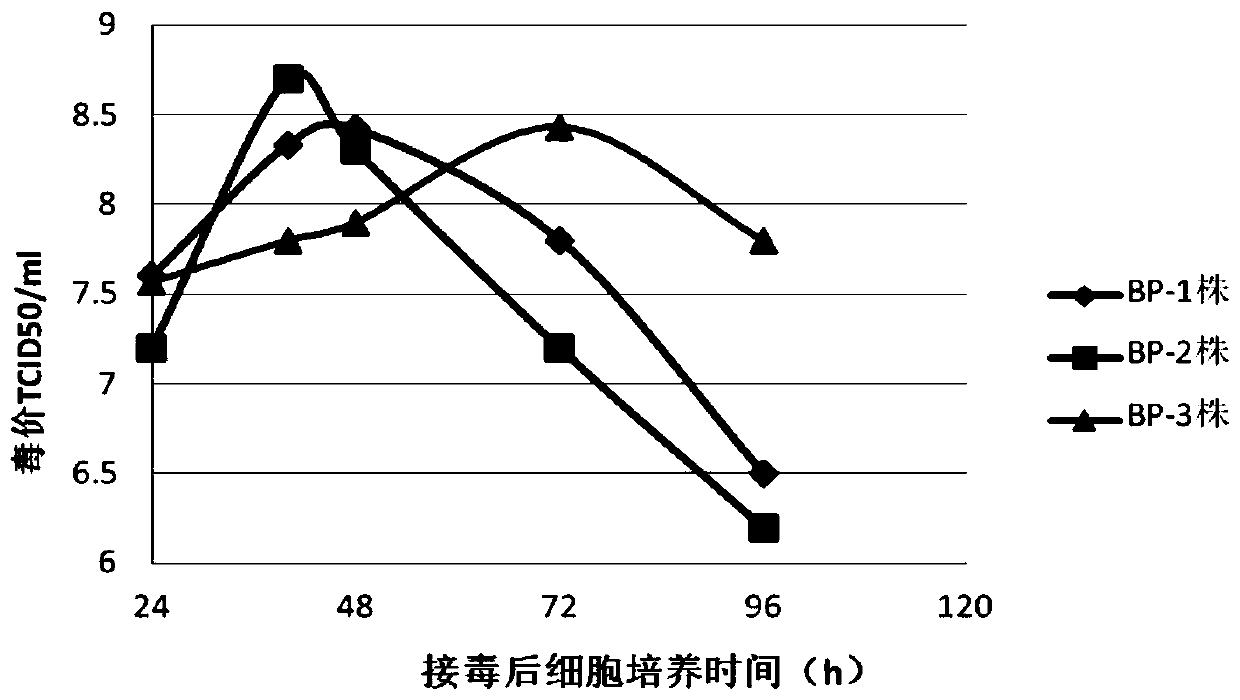BHK-21 cell line BHK-21-BP-2 clones and application thereof in full suspension cell culture
A technology of BHK-21-BP-2 and BHK-21, applied in the field of veterinary biological products, can solve the problems of unsuitability for large-scale production of vaccines, large differences between vaccine batches, and occupying a lot of space, and achieve excellent immunogenicity and security, high integrity, high integrity effect
- Summary
- Abstract
- Description
- Claims
- Application Information
AI Technical Summary
Problems solved by technology
Method used
Image
Examples
Embodiment 1
[0047] Example 1 Suspension acclimatization of BHK-21 adherent cells
[0048] The 3 strains of BHK-21 adherent cell clones from different sources that were cryopreserved were resuscitated, and the DMEM culture medium containing 8% (v / v) fetal calf serum (product of Hyclone Company, product code: SH30022.01) was used in a 75cm 2 Cell culture flasks. When the cells grow into a dense monolayer and the growth state is good, discard the original culture medium, add 0.25% trypsin for digestion, blow and disperse the cells into a single cell suspension with a pipette gun, and dilute the cells with 1×10 6 The density of cells / ml was respectively inserted into 250ml Erlenmeyer shake flasks, and the culture medium was cultured by using the original culture medium (DMEM containing 8% (v / v) fetal calf serum) and the suspension medium BHK201 mixed in different proportions. During the cultivation process, gradually reduce the ratio of the original medium to the suspension medium, and the r...
Embodiment 2
[0053] Example 2 Screening and performance analysis of 3 strains of BHK-21 suspension clones
[0054] 1. Toxicity analysis
[0055] BHK-21-BP-1, BHK-21-BP-2, and BHK-21-BP-3 obtained in Example 1 were cultured in 250ml cell shake flasks respectively, and the suspension culture The culture medium is BHK201, the culture volume is 30-50ml, and the culture condition is 5% CO 2 , 37°C, 120rpm. After culturing for 48h, the ZY-2014 strain of pseudorabies virus was inoculated respectively according to MOI=0.5, and the cells in different growth stages were sampled, counted and determined for 0h before inoculation, 24h, 40h, 48h, 72h, and 96h after inoculation ( supernatant). When sampling, there is no need to freeze and thaw, and the supernatant poison value of the sample is directly measured after the sample is centrifuged.
[0056] The result is as figure 1 and figure 2 As shown, compared with the other two clones, the suspension cell BHK-21-BP-2 clone had a lower number of cu...
Embodiment 3
[0085] Example 3 BHK-21 cell line BHK-21-BP-2 clone suspension cells cultured in a bioreactor
[0086] The BHK-21 cell line BHK-21-BP-2 clone was cultured in a shake flask for 1 to 3 generations, expanded to the number of cells required for inoculation in a 10L bioreactor, transferred to a 10L bioreactor, and Add suspension medium BHK201 to make the final cell concentration 0.4~0.8×10 6 cells / ml. Under the conditions of 36.5±0.5℃, pH value 7.2±0.1, DO value 30%~60%, stirring speed 60rpm~150rpm (stirring speed varies with cell density), culture for 48h~72h, when the cells in the reactor The density reaches 3~6×10 6 cells / ml, it is used for further amplified culture or inoculation.
PUM
 Login to View More
Login to View More Abstract
Description
Claims
Application Information
 Login to View More
Login to View More - R&D
- Intellectual Property
- Life Sciences
- Materials
- Tech Scout
- Unparalleled Data Quality
- Higher Quality Content
- 60% Fewer Hallucinations
Browse by: Latest US Patents, China's latest patents, Technical Efficacy Thesaurus, Application Domain, Technology Topic, Popular Technical Reports.
© 2025 PatSnap. All rights reserved.Legal|Privacy policy|Modern Slavery Act Transparency Statement|Sitemap|About US| Contact US: help@patsnap.com



